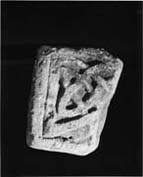Select a site alphabetically from the choices shown in the box below. Alternatively, browse sculptural examples using the Forward/Back buttons.
Chapters for this volume, along with copies of original in-text images, are available here.
Object type: Part of cross-arm
Measurements: H.17.5 cm (7 in); W. 14 cm (5.5 in); D. 19 cm (7.5 in)
Stone type: Hartlepool and Roker dolomite
Plate numbers in printed volume: Pl. 13.50-53
Corpus volume reference: Vol 1 p. 46
(There may be more views or larger images available for this item. Click on the thumbnail image to view.)
A (broad): Enclosed in a wide flat-band moulding is a U-bend terminal with outer bar terminal.
B (narrow): No pattern survives.
C (broad): Part of a wide flat-band moulding survives and part of two simple pattern E loops.
D (narrow): Enclosed in a wide outer flat-band and narrow inner roll moulding, is an indecipherable interlace.
The cutting of the interlace is fairly fine, as on 1, 2 and 8. The stone differentiates it, like 8, from the figural group. It is compared by Adcock with Hart 2, 4-5 and Billingham 3, which have the same chiselled strands and uneven patterns. This could be the earliest of the surviving fragments.



